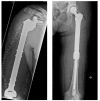The use of megaprostheses for reconstruction of large skeletal defects in the extremities: a critical review
- PMID: 25352933
- PMCID: PMC4209493
- DOI: 10.2174/1874325001408010384
The use of megaprostheses for reconstruction of large skeletal defects in the extremities: a critical review
Abstract
In the case of primary malignant tumors, extensive metastatic disease, major trauma or end-stage revision arthroplasty, the orthopaedic surgeon often has to deal with the need to reconstruct large skeletal defects, or replace bone of low quality. In the past years this was frequently impossible, and the only solution was amputation of the extremity. Later, the introduction of custom-made endoprostheses capable of reconstructing large skeletal defects, also known as megaprostheses, allowed for sparing of the extremity. This was especially valuable in the case of oncologic orthopaedic surgery, as advances in the medical treatment of sarcoma patients improved prognosis and limb-preserving surgery proved to have comparable patient survival rates to amputation. However, custom-made designs were implicated in frequent mechanical failures. Furthermore, they were extremely difficult to revise. The introduction of modular endoprostheses in the 1980s marked a new era in orthopaedic oncologic surgery. Modular megaprostheses consist of a number of different components in readily available sets, which can be assembled in various combinations to best address the specific bone defect. Moreover, they proved to have considerably lower rate of mechanical failures, which were also much easier to address during revision surgery by replacing only the parts that failed. The functional outcome after reconstruction with megasprostheses is often very satisfactory and the patient can enjoy a good quality of life. Nowadays, the major challenge is to eliminate the rate of non-mechanical complications associated with surgery of that magnitude, namely the risk for wound dehiscence and necrosis, deep infection, as well as local recurrence of the tumor. In our present mini-review, we attempt to make a critical approach of the available literature, focusing on the multiple aspects of reconstructive surgery using megaprostheses. We present the evolution of megasprosthetic implants, the indications for their use, and describe the outcome of surgery, so that the non-specialized orthopedic surgeon also becomes familiar with that kind of surgery which is usually performed in tertiary centers. A special interest lays in the recent developments that promise for even better results and fewer complications.
Keywords: Endoprosthetic reconstruction; megaprosthesis..
Figures
References
-
- Bacci G, Ferrari S, Longhi A, Forni C , et al. Neoadjuvant chemotherapy for high grade osteosarcoma of the extremities long-term results for patients treated according to the Rizzoli IOR/OS-3b protocol. J Chemother Florence Italy. 2001;13(1): 93–9. - PubMed
-
- Eckardt JJ, Eilber FR, Dorey FJ, Mirra JM. The UCLA experience in limb salvage surgery for malignant tumors. Orthopedics. 1985;8(5): 612–21. - PubMed
-
- Meyers PA, Heller G, Healey J, Huvos A , et al. Chemotherapy for nonmetastatic osteogenic sarcoma the Memorial Sloan-Kettering experience. J Clin Oncol Off J Am Soc Clin Oncol. 1992;10(1): 5–15. - PubMed
-
- Buchman J. Total femur and knee joint replacement with a vitallium endoprosthesis. Bull Hosp Joint Dis. 1965;26: 21–34. - PubMed
-
- Salzer M, Knahr K, Locke H , et al. A bioceramic endoprosthesis for the replacement of the proximal humerus. Arch Orthop Trauma Surg Arch F r Orthop Unf-Chir. 1979;93(3): 169–84. - PubMed
LinkOut - more resources
Full Text Sources
Other Literature Sources
Miscellaneous

